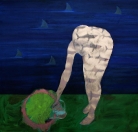ZBYNĚK HAVLÍN
SOFT VISION
26. 10. – 23. 11. 2012
Zbyněk Havlín ranks among the few young generation artists who, in addition to being successful at home, have also been able to establish themselves abroad, particularly in Austria and Germany. Studies at the Academy of Fine Arts in Prague, in Professor Milan Knížák’s Studio of Intermedia Arts, made a significant impact on his work and confirmed his broad artwork portfolio, encompassing paintings, drawings, sculptures, objects, design, installations, performances and new media – photography and video. The connecting link is Havlín’s conceptual way of thinking.
When watching the artist’s evolution in the area of paintings in the last few years, I have assured myself that Zbyněk Havlín possesses several ways to express himself even through the traditional medium, which are linked by his state of mind. He is a truly multifaceted artist. I perceive the canvases presented at his current exhibition as conceptual images. However, my feeling is that, in a certain stage, the process of painting absorbs the artist so much that the concept “steps back”. The struggle between the rational and the emotional remains unsolved. Havlín’s unwillingness to accept “radical solutions” in his paintings produces a special calming impression. Even the effect of some symbols the content of which need not necessarily be positive is surprisingly soothing.
The author explains his “Soft Vision” as follows: “I am reacting to efforts to de-radicalize the image by too many meanings or explicit definitions. The paintings of this series are intended to attract especially by permeability of open-ended actions and meanings. There is no dictate, no unambiguous interpretation. One has to become smoother to permeate through different templates and to make the image move in his or her mind.” The ambiguity is the greatest quality of the works on display. Individual layers of the image do not organically blend into one another. Instead, primary plots play a fairly significant role, asserting themselves against the resulting composition and shifting the emphasis, in a skewed fashion, to the principal idea. While certainly not common, the approach leaves the spectator with an impression that he or she has not been told everything and that he or she has to try to decipher the meaning himself/herself; this contributes to the poignancy and attraction of Havlín’s canvases. For example, let us have a look at shapes standing in the water and almost certainly looking at the opposite bank. The absurdity of the almost surrealistic element once again gives the work a meaning leaving us in existential uncertainty. Similarly, I could turn the artist’s gender emancipation efforts into a desire to celebrate the Fathers’, Gamekeepers’ and Hunters’ Day. In my view, the author’s vision is not necessarily more complex, but it is infinitely more refined and completely lacking the common masculine aggression. The message of some other works may be more literary, but their immense poetry elevates them to another, higher level.
Zbyněk Havlín’s paintings are outstanding in their sincerity and integrity of the creative idea. The author’s dreaminess and guilelessness make a truly cleansing impression on me. I would be happy if you left the exhibition with at least some of these feelings as
PhDr. Rea Michalová Ph. D.


